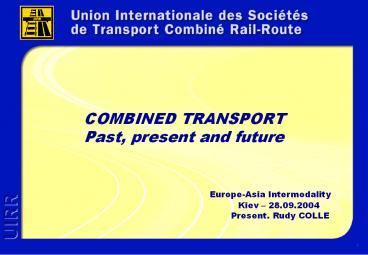COMBINED TRANSPORT Past, present and future Europe-Asia Intermodality Kiev - PowerPoint PPT Presentation
Title:
COMBINED TRANSPORT Past, present and future Europe-Asia Intermodality Kiev
Description:
Founded October 1970 Munich. Two-level organisation (decentralised structure) ... Non-application of Sunday / holiday embargo provisions ... – PowerPoint PPT presentation
Number of Views:410
Avg rating:3.0/5.0
Title: COMBINED TRANSPORT Past, present and future Europe-Asia Intermodality Kiev
1
COMBINED TRANSPORTPast, present and future
Europe-Asia Intermodality
Kiev 28.09.2004
Present. Rudy COLLE
2
DefinitionsSource EC/ECMT/UNO
- MULTIMODAL TRANSPORTCarriage of goods by two or
more modes of transport - INTERMODAL TRANSPORTThe movement of goods in one
and the same loading unit or road vehicle, which
uses successively two or more modes of transport
without handling the goods themselves in changing
modes - COMBINED TRANSPORT (CT)
- Intermodal transport where the major part of the
European journey is by rail, inland waterway or
sea and any initial and/or final leg carried by
road are as short as possible
3
CT Techniques
Unaccompanied Transport
Accompanied Transport
4
Comparison CT and Road Haulage
5
CT operators
- 3 main groups
- The railway undertakings (RU)
- RU subsidiary companies - Intercontainer (ICF)
- - Transfracht
- -
- Private operators - UIRR member companies
- - others (Transfesa,)
6
UIRR s.c.r.l.
Founded October 1970 Munich
- Two-level organisation (decentralised
structure) - LIAISON OFFICE BRUSSELS
- overall promotion of CT - political instances
EU/ECMT/UNO - - professional bodies (IRU/UIC/EIM/
- CER/FIATA/CLECAT,)
- coordination of members activities
- service center (projects, reports)
- MEMBER COMPANIES
- organising and marketing of CT
- waggons in ownership management of
transhipment yards (terminals)
7
UIRR membership 2004(in 13 EU countries and
Switzerland)
- FULL MEMBERS (18)
- CT as their main activity
- registered capital held by
- (majority) road hauliers and forwarding agents
- (minority) RU and other UIRR members
- mostly terminal-to-terminal operations
- ASSOCIATED MEMBERS (1)
- CT as a subordinate activity
8
UIRR membership 2004 - Map
9
UIRR Traffic Development (1986-2003)
10
UIRR traffic data 2003
Full Members Full and Associated members
Total traffic Total traffic Total traffic
- Consignments- TEU- Tkm- Tons 2,1 Mio.4,7 Mio.34 Billion48 Billion 2,3 Mio.5,3 Mio.-53 Billion
Breakdown per technique Breakdown per technique Breakdown per technique
- Accompanied- Unaccompanied Swap bodies / containers Semi-trailers 2278 70 8 100
Breakdown per geographical scope Breakdown per geographical scope Breakdown per geographical scope
- National- International 3367 3862
11
UIRR traffic breakdown per technique (2003)
Semi-trailers
Rolling Motorway
Swap Bodies Containers
12
Future Development (1)
- EU policy (White Paper 2001)
- Modal split 2010 1998
- If no change in trends HDV 50
- If White Paper successful HDV 38
- meaning Rail freight 50
- CT 100
- With short sea Road 44 Rail 8 SSS 41
Inland Waterway 4 Pipelines 3 - Without short sea Road 74 Rail 14 SSS -
Inland Waterway 7 Pipelines 5
13
Future Development (2)
- CONDITIONS (1)
- Framework conditions
- Fair and equal opportunities of market access
for all modes, through - Rail liberalisation (gt competition gt quality)
- Equitable allocation of infrastructure and
social costs to all modes - Regard for social and operational regulations
- Infrastructure appreciations
- Swifter implementation of political decisions
14
Future Development (3)
- CONDITIONS (2)
- Economic constraints
- Massification of traffic (i.a. back to back)
- Expansion (i.a. geographical)
- Responding to customers expectation
- Quality
- Pricing
- Information
Proper interfacing and network supplyestablished
role of UIRR
15
Expansion to the East
- Difficulties
- Track width
- State of the rail infrastructure
- Terminal capacities and equipment
- Financing of elimination of bottlenecks
- Transport security
- Customs procedures
- Climate
- Commercial mind
- Different mentalities
16
Advantages of CT general
- relief of the road network
- transfer of goods to a safer and
environment-friendly transport mode - better sharing of transport volumes between modes
- recourse to available transport capacities
- co-operative activity combining the advantages of
road (flexibility) and rail (more economical,
mass transport on larger distances) - competitiveness in given circumstances
17
Advantages of non accompanied CT
- Savings in variable costs (fuel, tyres,
maintenance) - Reduction in personnel (drivers, driving hours,
night work) - Easier enforcement / control over work
regulations - Improved organisational flexibility
- Exemption / reduction of vehicle/taxes
- Avoidance of road circulation/taxes
- No/less road transport permit requirements
- Reduced vehicle parks and subsequent capital
appropriation needs - Non-application of Sunday / holiday embargo
provisions - Less damage claims relative to transported goods
18
Advantages of accompanied CT (RoMo)
- Overall cost advantages vs. full-road
transportation - Border crossings without permit requirements
- Reimbursement of vehicle taxes
- Savings on circulation taxes
- Train-trip recognised as drivers rest-time
- Weight advantage in Alpine transit
- Exemptions from Sunday/holiday interdictions
- Easier customs-clearance in terminals































